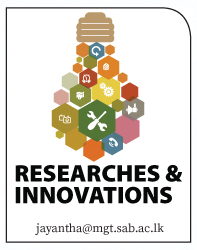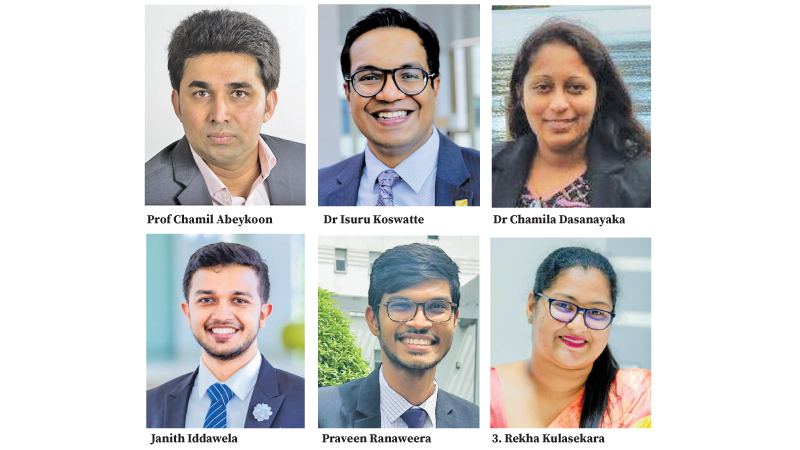Sri Lanka has considerable potential to utilise energy from renewable sources such as solar, wind, and hydropower. This study conducted a systematic review followed by a time series analysis to evaluate the current state of renewable energy development in the country and to uncover any discrepancies within these initiatives through the time series evaluation.
 The initial findings revealed a deficiency in collaboration among relevant agencies and conflicting government policies, including increased investments in non-renewable energy sources and a decline in support for initial investments needed to promote the adoption of renewable resources by businesses and smaller entities.
The initial findings revealed a deficiency in collaboration among relevant agencies and conflicting government policies, including increased investments in non-renewable energy sources and a decline in support for initial investments needed to promote the adoption of renewable resources by businesses and smaller entities.
The research also highlighted transportation and non-renewable power generation as the main barriers preventing the country from creating a viable plan to achieve net zero by 2050.
Furthermore, from a non-governmental perspective, the study detected a lack of knowledge and awareness among the public regarding the long-term benefits of transitioning to renewable sources.
Renewable energy supply of Sri Lanka
In the 2018 Environmental Performance Index (EPI) rankings, which assessed 180 countries, Sri Lanka was 70th, while Switzerland and Burundi held the 1st and 180th positions, respectively. As a country that heavily depends on fossil fuels, Sri Lanka faces increasing air pollution unless the government advocates for and implements clean energy technologies to meet the nation’s energy requirements.
As per estimates, 39 percent of Sri Lanka’s total energy supply (TES) will stem from renewable energy sources by 2020.
When compared with its counterparts in the SAARC region, Sri Lanka’s contribution to TES from renewable energy sources stood above countries such as Maldives (one percent), Afghanistan (19 percent), India (24 percent), Pakistan (24 percent), and Bangladesh (26 percent) and well below the percentage contributions of Nepal (75 percent) and Bhutan (87 percent).
While the country’s renewable energy contribution remains above par when compared within the region, Sri Lanka’s renewable energy contribution to the TES had a 1.8 percent growth in comparison to its contribution in 2015, making Sri Lanka the only country within the SAARC region to record a negative renewable energy source contribution growth during the 2015–2020 period.
Key findings of this research
A strategic approach to utilising and integrating renewable energy resources highlights the importance of formulating national policies that address energy security, energy economics, environmental concerns, financing, technological advancement, and research and development. The energy policies and strategies in Sri Lanka emphasise advancing conventional and nonconventional renewable energy sources for power generation.
Encouraging the use of domestic energy resources has emerged as a critical element of Sri Lanka’s policy framework. The primary nonconventional renewable energy sources promoted for grid-connected power generation in Sri Lanka are small hydropower, biomass energy, and wind power.
From a policy standpoint, there is insufficient coordination and collaboration among various governmental institutions, indicating a need for better alignment among these entities in the policy-making and decision-making processes. Since the late 20th century, Sri Lanka’s rapid economic growth has been closely linked to the increase in the country’s overall energy consumption. The demand for energy in Sri Lanka has consistently risen, with electricity consumption climbing from around 2.5 TWh annually in 1985 to over 15 TWh by 2020. Renewable energy accounted for almost all Sri Lanka’s energy needs until 1995.
However, as the total energy demand surpassed the 5 TWh threshold during the 1995–1997 period, Sri Lanka was compelled to explore various energy generation options to satisfy this demand, resulting in a significant decline in the share of renewable energy sources, which provided less than 50 percent of the nation’s energy needs consistently after the dawn of the 21st century.
When assessing Sri Lanka’s energy profile based on the time series analysis, it is understood that hydroelectric energy has remained the country’s single most valuable renewable energy generation source for the last few decades. Until the late 90s, hydropower acted as the country’s critical energy generator, producing nearly all of Sri Lanka’s energy requirements.
Moreover, in the past two decades, Sri Lanka has identified the potential for wind, bio energy, and solar as alternative energy sources.
However, the current contribution from these three renewable sources in comparison to hydroelectricity remains significantly low.
Furthermore, Sri Lanka has also seen an increase in the energy generated through bio energy sources (geothermal, biomass, and waste energy), with this segment producing approximately 250 GWh of energy by 2020.
Implications of this research
A significant factor driving the growth of renewable energy initiatives in Sri Lanka is the presence of dedicated institutions addressing the matter. A crucial foundation for this was the establishment of necessary guidelines for sustainable development by the Sri Lankan Ministry of Environment and National Resources (MENR) in 2007. One of the main challenges facing the current energy sector in Sri Lanka is the high economic costs compared to the non-renewable energy sector, particularly in the short to medium term.
Despite the country’s potential for solar and wind energy, support for local manufacturing of components is lacking. Furthermore, most renewable energy technologies related to wind, solar, and other significant sources are relatively new in the Sri Lankan context, which results in high production costs per unit and significant initial investments needed to establish the relevant facilities.
Transitioning to renewable energy sources is vital for alleviating pressure on Sri Lanka’s balance of payments and channelling more financial resources into other necessary imports. If Sri Lanka successfully transitioned to renewable energy sources, it could save approximately US$18 to US$19 billion on coal imports, thus making a substantial contribution to the country’s economy.
As a developing nation, Sri Lanka largely relies on importing renewable energy technologies from abroad, with minimal knowledge transfer occurring. For instance, solar panels and other essential renewable energy equipment imported from China are increasingly appealing to customers due to their lower prices, despite concerns regarding their quality and reliability over the long term.
Key Takeaways
Although Sri Lanka has access to abundant renewable resources (wind, water, sun), there is disorganisation and lack of accountability among various governing bodies and legislative authorities in promoting the transition.
Even with the year-on-year increase in renewable sources, the contribution percentage of renewable energy continues to decline steadily. The results indicate that Sri Lanka has shifted from a rural economy to an urban one, focusing more on manufacturing and services.
The mixed signals from the Sri Lankan government and regulatory agencies may convey a weak and unclear message to businesses and other stakeholders interested in investing in long-term net-zero technologies.
This article is based on the below-published source:
Koswatte, I., Iddawala, J., Kulasekara, R., Ranaweera, P., Dasanayaka, C. H., & Abeykoon, C. (2024). Can Sri Lanka be a Net-Zero Nation by 2050?–Current Renewable Energy Profile, Opportunities, Challenges, and Recommendations. Cleaner Energy Systems, 100126, https://www.sciencedirect.com/science/article/pii/S2772783124000207
Authors
Dr Isuru Koswatte, School of Business and Creative Industries, University of the West of Scotland, United Kingdom&Adjunct Senior Research Fellow, NSBM Green University, Sri Lanka
Janith Iddawela, Faculty of Business, NSBM Green University, Sri Lanka, and PhD Candidate, Murdoch University, Australia
Rekha Kulasekara, Faculty of Business, NSBM Green University, Sri Lanka
Praveen Ranaweera, Faculty of Business, NSBM Green University, Sri Lanka
Dr Chamila Dasanayaka, Institute of Business Industry and Leadership, Cumbria University, United Kingdom
Prof Chamil Abeykoon, Northwest Composites Centre, Aerospace Research Institute, and Department of Materials, Faculty of Science and Engineering, University of Manchester, United Kingdom




